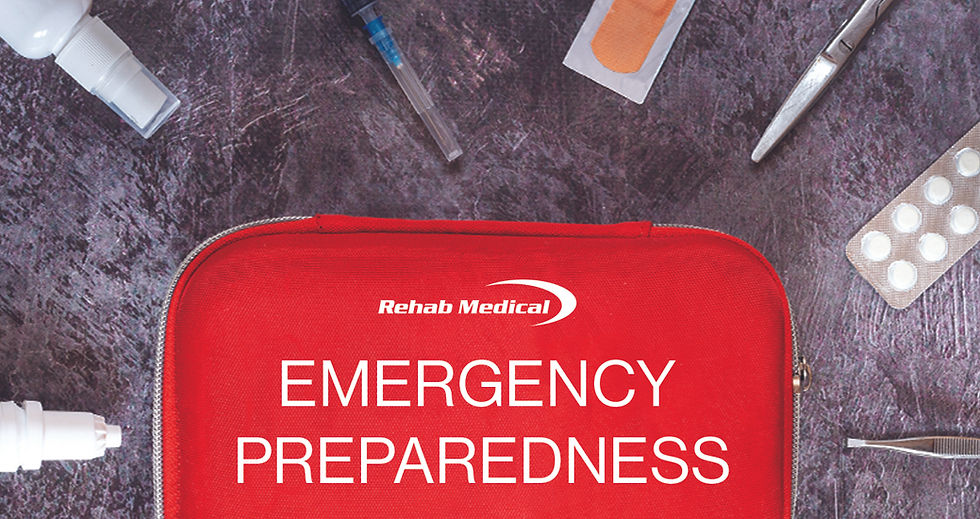Elder Abuse or Cognitive Disease: How to Tell the Difference to Combat the Issue
- Rehab Medical

- Jun 23, 2023
- 3 min read

Elder abuse has been increasing for nearly two decades, causing 1 in every 10 elderly Americans to become susceptible to neglect and exploitation. It’s becoming a widespread epidemic since 17% of the U.S. population is made up of people over the age of 65. To help raise awareness for change and combat future occurrences, Rehab Medical has put together a snapshot of common elder abuse signs and how you can prevent this from happening to your loved one.
What is elder abuse?
In its simplest form, elder abuse is classified as an intentional act or failure to act on something that causes mental or physical harm to the recipient. Unfortunately, these acts are more common among those close to the recipient of care such as a family member or existing caretaker.
Why is elder abuse so common?
Elder abuse is common because many of the recipients suffer from some form of disability causing them to be reliant on others for daily functions. According to the U.S. Department of Justice, 26% of elderly people with a disability are subject to abuse. Additionally, insurance fraud plays a pivotal role in abuse. Whether you are someone with a disability or not, after a certain age, you become eligible for the government funded insurance plans such as Medicare or Medicaid. As stated by the Coalition Against Insurance Fraud the cost of insurance fraud is estimated to cost Americans more than $300 billion annually.
Effects of cognitive disease or elder abuse: How to tell the difference
While aging is a graceful part of life, it doesn’t come without its challenges. As we get older, we begin to lose some of our basic human characteristics such as hair color, vision, hearing, and certain motor skills. But for some older adults, the aging process can be especially challenging if Alzheimer’s, Dementia, or Parkinson’s plays a role because a lot of accusations can be mistaken for the wrong prognosis.
So, what are some ways you can differentiate between effects of a cognitive disease and when abuse is taking place?
Effects of cognitive disease:
Frequent behavioral changes
Loss of memory
Wandering or getting lost
Unexpected emotional triggers
Frequent outbursts
Inability to remain calm
Signs of elder abuse:
Malnutrition
Neglect
Unsanitary living conditions
Untreated medical conditions like pressure sores
Over or under medicating
Changes in financial situations like the addition of an authorized user or unplanned changes in posthumous arrangements
While a lot of these signs seem easily identifiable, they can easily be confused when assessed under different circumstances. It’s important to keep an open line of communication between you and your loved one so you can address any concerns as soon as possible. Additionally, it’s recommended to schedule frequent check-ins if your loved one is in a facility or uses an in-home caregiver. Daily Caring published an excellent article on how you can safely conduct these check-ins. If you find your loved one has experienced any of the above signs, seek appropriate assistance as soon as possible.
Standing against elder abuse
Protecting our older population so they can live healthy lives is something we can all help with. If you have a family member or friend in a situation where they are taken advantage of, you have every right to step in and help support them on their behalf. We've put together a list of valuable resources specific to reporting signs of elder abuse.
Call your local Adult Protective Services (APS) agency. Your report will be confidential for privacy purposes.
Visit the National Center of Elder Abuse a website designed to find your state’s phone numbers, government agencies, and any detailed information needed for assistance.
Call the Eldercare Locator at 1-800-677-1116 for information or a referral to the correct local agency
Contact the long-term care ombudsman to get help with problems in an assisted living community
Call the Alzheimer’s Association at 1-800-272-3900
Caregivers, whether it be a friend, family member, or hired helped, the possibility of abuse can occur at any given point in time. For additional resources on how to prevent elder abuse, click here.




Comments